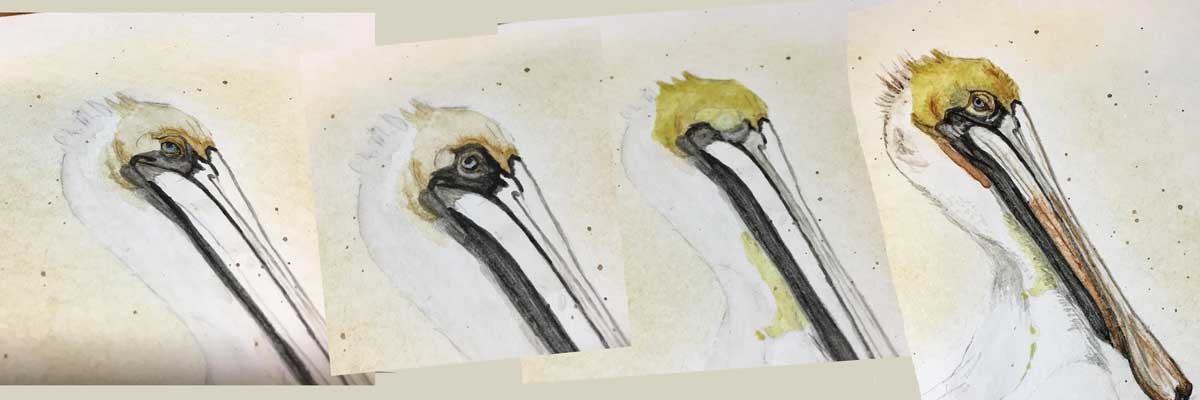This painting of a Louisiana Brown Pelican was based mostly on a photo by Shelby Townsend , but I liked the feet on another from U.S. Fish and Wildlife Service, so modified them to drape over the edge of the post.
The Model for my Subject
Here’s Shelby’s story about the day he took the photo.
I remember taking that shot. We were riding a ferry across some small body of water somewhere in south Louisiana and he or she posed perfectly on that pole in some very good lighting so I could capture that shot… ~ Shelby Townsend
The Pelican’s Color Palette
These are the colors I’m using on the painting. All of them except the lapis lazuli for his eye and the French green clay I mixed with the gray are colors I made from rocks, clay, and sassafras leaves from here at Wild Ozark. The sassafras is the only plant-based paint that has good light fastness. All of the others I’ve tried have faded to nearly nothing in my sunlight tests within a few days. The sassafras actually intensified in color, and it’s my only source of really clean yellow. So far. I might find others sooner or later. But I’m happy with this one.
Getting Started
The first thing I always have to do when I start a new painting is the eye. I’ve had the hardest time with the eye on this guy. Who knew it would be so hard to get a pelican’s eye just right?
Pelican Eyes
Turns out that a pelican has a lot of lines in his face. And his feathers go to a certain point on his face but then they stop and it’s just skin. So many little details. On my first attempt, I did a pretty decent job. I liked his blue eye.
Then I had to go and try to make it better. And what happened? Of course. I messed it up.
So I erased his eye. And all of the black lines I’d added around his face. It was just too much black. I seem to have a weakness for doing that. The same thing happened with both kestrels. I can’t keep my brush out of the black.
Anyway, I got his eye erased and re-painted, and the second go around actually looks more realistic than the first, if you ask me.
I’m using mostly Ozark colors on this Louisiana brown pelican. But I needed some blue for his eye and that’s not something I can get from our local stones. So I used a little bit of my precious lapis paint.
Moving On
Once I finished getting the pelican eye done to a point where I liked it, I began working on the bill, then his head, and finally to the color blocks for the rest of his body. Turns out that a pelican bill is pretty tricky too. There’s a lot of nuance in shape and lines, and it was very difficult to paint it in the way to make it look like what I saw in the photographs. And brown pelicans seem to come in all shades of colors with yellow, browns, black and russets. Perfect for the paints I make.

The Finished Painting

About the Painting
The paper is heavyweight, sized 8″ x 10″. (Strathmore 400 series watercolor paper)
This pelican is a birthday gift for my sister. I’ve never really looked closely at a pelican before. They’re very odd looking creatures!
If you want to follow along and see the progress pics of other paintings as I do them, catch up with me over at Instagram. I’m @wildozark there too.
Have a great weekend!









Leave a Reply